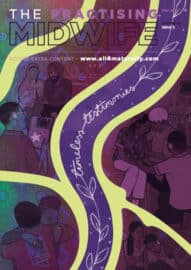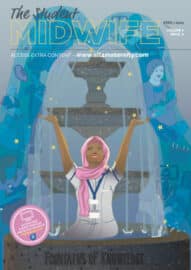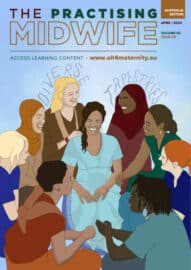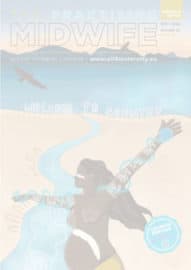Maternal Journal – how creative journaling can support pregnant women and new mothers with a history of mild to moderate mental health problems
Journaling: ‘a record of experiences, ideas, or reflections kept regularly for private use’ (Merriam-Webster, 2018)

Introduction
There is growing recognition of the serious nature of maternal mental health problems during childbirth – with one in five women in the UK developing a mental health illness during pregnancy or up to one year after birth (RCPG, 2018), seven in ten hiding or underplaying the severity of their illness, and suicide as one of leading causes of death during this time (Everyone’s Business, 2018; MBRRACE, 2017). Furthermore, services for and understanding of perinatal mental health is patchy, with the threshold for conventional treatments high. This leads to many women with mild to moderate symptoms having little specialist support, leaving midwives, GP’s, health visitors and women’s families increasingly stretched to help, and women and babies suffering, the consequences of which can have dire short, medium and long-term effects.

Maternal Journal was an interdisciplinary collaborative project, produced by myself – artist and midwife Laura Godfrey-Isaacs, and psychiatrist Carmine Pariante, Professor of Psychological Medicine at King’s College London, which explored the therapeutic potential of journaling as a way to promote wellbeing and positive mental health for pregnant women and new mothers, who have a history of mild to moderate depression and/or anxiety. The project was brokered (and funded) by the Cultural Institute at King’s through its Arts in Mind Scheme, and was supported by midwifery advisor Debra Bick, Professor of Evidence Based Midwifery at The Department of Women and Children’s Health at King’s.
Through this project, we aimed to explore the positive effects and potential therapeutic qualities of ‘journaling’ on the mental health and wellbeing of the participants and provide the opportunity to build a unique and regular practice of journaling, which could be taken forward into pregnancy and early parenthood.

The project involved a series of workshops, facilitated by myself and Carmine, that included creative activities introduced by visual and craft artists, poets, cartoonists and writers; Hollie McNish, Kate Evans (aka Cartoon Kate), Frances Burden, Rebecca Fortnum and Sharon Boothroyd. At each workshop, one of the artists devised creative exercises, using different writing and visual arts techniques that supported participants to create the journal as an expansive, therapeutic, creative aspect of their care through pregnancy. In addition, the sessions involved participants sharing work they had made in between the meetings and any experiences or concerns they had, therefore building in psychosocial support for participants and cohesion within the group. This lead to a strong practice of sharing and support within the group, with participants feeling safe enough to reveal and explore thoughts, feelings and experiences openly. Discussions ranged from personal accounts of physical, psychological and emotional struggles with pregnancy and mothering to social, political and cultural issues referenced through the media, art and medical frameworks.

Why Journaling?
Maternal Journal builds on the tradition of women’s journaling which has a strong female legacy, and involved looking at a range of creative forms such as the sketchbook, diary, scrapbook or devices such as video diaries, blogging, twitter or instagram – which encouraged women to find their own way to use the journal and their own ‘voice’ within it.
Journaling can be a powerful creative tool and social document employed by women in their everyday lives. It is also a common form used by well-known women writers and artists. It is also suggested that it can also act as a therapeutic device by providing a means to check in on feelings, help to understand triggers towards poor health, document good and bad days, and put experiences into perspective. Journaling, and the creative expression through it, can be cathartic, joyous and revelatory as well as a means to expose and reveal feelings otherwise hidden or suppressed.

Journaling in pregnancy has particular poignancy as it relates to the inevitable marking of time, the nature of the experience as ‘a journey’, the sense of being in a liminal space (a threshold between one state and another), and the creativity of making a baby. It is also commonly a time of great imagination – of the baby, of becoming a mother, of birth – with associated vivid dreams and fantasies: all good material for a journal. What’s more, it is also a time of great change, challenge, opportunity and vulnerability, particularly if you have a history of mental health problems – so having a creative outlet can be highly productive.

The history of female journaling
The rich history of female journaling comes about partly due to it having been one of the only possible ways for women to write, be creative or express social and political views in the past (when professional engagement wasn’t possible), employing a semi- or wholly private guise. Therefore, journaling can be seen culturally, even today, as a powerful way for women to document their experiences, and create a social history of their lives.
During the project, we connected our participants to this history by looking at some key women’s diaries, journals and sketchbooks: by Frida Kahlo, Virginia Woolf, Bobby Baker, Anne Frank, and mass observation diaries.
We explored how journals can take different forms and how it could be conceived as private or for a wider readership – and how it can include reflection, analysis, creative release, as well as being personal and intimate, and a source of pride through developing one’s own voice and personal expression.
We looked as far back as Fanny Burney in the 18th century, who wrote her first journal aged 15 years – which combines many different genres: a personal memoir, a series of letters to an intimate friend, a political and social history, a working notebook and also a fiction with a compelling narrative.
Her diary was addressed to a certain Miss Nobody (Burney, 1768):
‘To have some account of my thoughts, manners, acquaintance and actions, when the hour arrives in which time is more nimble than memory, is the reason which induces me to keep a journal. A journal in which I must confess my every thought, must open my whole heart!’
Another key writer we introduced was Virginia Woolf, 20th century author of the seminal ‘A room of one’s own’ – who kept a journal for 26 years starting at the age of 22.
‘What sort of diary should I like mine to be? I should like it to resemble some old desk, or capacious hold all, in which one flings a mass of odds and ends without looking them through.’
Contemporary women’s journaling
In addition, we researched contemporary artists, such as performance artist Bobby Baker – whose diary art, Mental health and me, documents 11 years of mental distress and treatment, through a daily drawing practice.
‘I have found a distinct correlation between the act of making these regular drawings of myself and my life, and the act of self-reflection which has led to a greater awareness, acceptance and understanding of the world and its ways – and ultimately helped me to recover.’

We also discussed contemporary diary-keeping, such as social media forms like blogs, Instragram, and Facebook – looking at the huge number of maternal blogs, such as ‘slummy mummy’ and ‘honest mum’.
Slummy Mummy blog:
‘As the author of this blog, I reserve the right to use poetic licence – although all posts will be based on real events or conversations that may have taken place, information may be changed, diluted or exaggerated to protect identities and avoid as much humiliation as possible and this site should be classed as a fictional site (just so no-one sues me).’
We also considered work by artists such as Louise Bourgeois, who made work about pregnancy, mothering and birth, and Frida Kahlo’s extensive sketchbooks.
Two of our workshop leaders, Hollie McNish and Kate Evans, have also produced powerful works about pregnancy, birth and mothering – Hollie’s book Nobody told me (2016) and Kate Evans books Bump and The food of love were subsequently looked at in detail.


Outcomes and Women’s feedback
The project received very positive feedback from the women and, what was originally planned to be a five-consecutive-week project during pregnancy, has grown into the postnatal period, with the group now meeting monthly. Most women have kept the journal going and have produced some incredible work, including drawings, paintings, collage, prose, poems and more.
Some of the feedback is documented below:
‘I feel energised and given permission and support to continue to find and establish my own space and voice creatively, at home and outside. This, in turn, makes me feel already less anxious and fearful about the impact of this baby on my sanity. Like I will have more tools at my disposal, should I feel myself teetering on the edge of depression again. The other aspect which I hugely value is how openly political it is, how different and broad the range of women, but all united, I think, in seeing and talking openly about how political motherhood and female mental health and work are. I find this such a relief and support.’
‘The weekly workshops are totally the highlight of my week: they’re fresh, different, so far away from my every day, so relevant to my life currently and exactly what I need. I’m loving being introduced to the artists and trying out things I wouldn’t have done on my own initiative. It’s inspiring and energy giving.’
‘The Maternal Journal as a concept and a working model is fantastic. I’ve found the past two sessions joyous, cathartic, hopeful, inspiring and informative. I feel blessed to have access to such a brilliant group.’
‘Creating the artwork itself was both cathartic and therapeutic. I felt valued as a pregnant woman.’
‘Keeping a maternal journal has been a very helpful and positive experience. I think it’s contributed to my continued mental stability.’

Next steps
Maternal Journal was conceived as a pilot project, mostly centred around the creative and psychosocial aspects of journaling and the group dynamic – however, we are now looking at possible research funding to re-design and run a larger project that could possibly be integrated into more routine NHS care. Exciting collaborations and links have emerged through the pilot and these will be explored during 2018 in order to help build and grow the concept.
We made some films documenting the project which can be accessed online here:
The Facebook page has information here:
https://www.facebook.com/maternaljournal/
There is information about the project on the King’s Cultural Institute page here:
https://www.kcl.ac.uk/Cultural/-/Projects/Maternal-Journal.aspx
Work from the project will also be presented at the Arts in Mind Festival, run by the King’s Cultural Institute and the Institute of Psychiatry at the Denmark Hill site in June (4th-10th), details to be confirmed. https://www.kcl.ac.uk/Cultural/-/Projects/Arts-in-Mind-Innovation.aspx
References
Everyone’s Business (2018) Available online at: http://everyonesbusiness.org.uk/?page_id=6 Accessed on: 27.02.18
MBRRACE-UK (2017) Saving Lives, Improving Mothers’ Care – lessons learned to inform maternity care from the UK and Ireland Confidential Enquiries into Maternal Deaths and Morbidity 2013-15 December 2017 Available online at: https://www.npeu.ox.ac.uk/mbrrace-uk/reports Accessed on: 27.01.18
Merriam-Webster (2018) Definition of Journaling – available online at: https://www.merriam-webster.com/dictionary/journal. Accessed on: 26.01.18
RCPG (2018) Perinatal Mental Health Toolkit Available online at: http://www.rcgp.org.uk/clinical-and-research/toolkits/perinatal-mental-health-toolkit.aspx Accessed on: 29.01.18
Birth, Art & Culture blog, March 2018 @godfrey_isaacs







